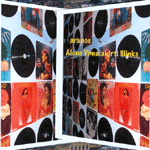- Administrator
- Albums and Singles
 Deer Tick's reissue has a couple of absolute gems and new cover art cleverly suggesting that they seek a rewardingly unfashionable sound midway between The Flying Burrito Brothers and The Mountain Goats.
Deer Tick's reissue has a couple of absolute gems and new cover art cleverly suggesting that they seek a rewardingly unfashionable sound midway between The Flying Burrito Brothers and The Mountain Goats.
This repackaged release is way better than the original for the simple reason that the cover art (a desert scene: girls in bikinis with automatic weapons, sunglasses, boys with cigarettes) is a visual representation of the music's advocacy of excess and an outsider stance. This tongue-in-cheek rakish image is borne out by the attitude on some of the songs on the pathetically titled War Elephant. Chief amongst the jewels is "Art Isn't Real (City of Sin)", an utterly fabulous track which rolls along in the old country-rock style; a swinging piece of strident, maudlin, existentialism that would not have disgraced The Gilded Palace of Sin. The song has a neat juxtaposition of a breezy pace and dispassionate delivery of killer lines such as: "I'm just going through the motions and/ I need an old fashioned potion/There's gotta be some old recipe/ "Cos I gotta get drunk I gotta forget about some things." The choice of fiddle instead of guitar for the solo on this piece is also spot on.
"Dirty Dishes" is a surrealistic track with jangling sound and lyrics that depict selfish people trying (in their on way) to be understood and, eventually, to empathize with others. "Spend the Night" has an atmosphere of straight ahead lewdness (no pun intended) and "Diamond Rings 2007" could be a cover of Big Star's "I'm in Love with a Girl." It's as if The Shins decided to go country. Unfortunately, heavier songs which could provide contrast, such as "Not So Dense," have such a stodgy pace that they could almost be from another band. These parts of War Elephant bog the whole album down. Likewise, John McCauley's voice is great on the lighter propulsive tracks but when he strains for some grittiness or anger it is far less attractive.
Back with the rakish attitude: it's a plus that sections of the liner notes smack of deliberate bullshit. Similarly, while it could be worrying that the final track, "What Kind of Fool Am I," was written by Anthony Newley, that influence worked just fine for Bowie. All in all, despite the inconsistencies I hope we haven't heard the last of Deer Tick and that the next cover art will picture McCauley smoking a pipe while a bald minder holds back droves of adoring bikini-clan fans.
samples:
Read More
- Administrator
- Albums and Singles
 Boston's Keith Kenniff is a frustratingly saccharine composer with plenty of talent but little equilibrium. His sober, painstakingly crafted arrangements are gorgeous hymns to the idea of beauty itself, at least in theory. In reality, some of his work is just a bit too stiff and composed for my ears.
Boston's Keith Kenniff is a frustratingly saccharine composer with plenty of talent but little equilibrium. His sober, painstakingly crafted arrangements are gorgeous hymns to the idea of beauty itself, at least in theory. In reality, some of his work is just a bit too stiff and composed for my ears.
Type
Kenniff has seen critics toss names like Boards of Canada and Brian Eno his way and, to some extent, I can understand those comparisons: his music lilts more than it drives, ascends more than it accelerates, and tends towards the pleasures of simplicity and ambient somnolence. What Eno and the Boards of Canada have that Kenniff doesn't is an exciting and singular appreciation for the unusual and unexpected. Helios' fifth record is a pretty, but predictable exercise in electronic composition. Kenniff provides layers and layers of synthetic harmony and dreamy melodies, which wash over softly plodding drum machines that sound as though they've been suffocated under a mountain of pillows. He repeats this process almost without fail for the better part of an hour and succeeds in creating a truly ambient (meaning wallpaper-esque) record from dynamic and decidedly un-ambient parts. Caesura is enjoyable, but it is also without enough dynamism to keep it interesting.
Songs like "Glimpse" and "Fourteen Drawings" are filled with expertly picked guitars and honeyed chimes that coalesce in such a fashion that they seem practically made for each other; they're wedded in the production so tightly that I can't imagine them begin separated or interrupted by any other sounds. This effect is lovely, but as the album progresses and it is revealed that nearly each and every song is produced in this manner, it becomes a little nauseating. Pretty melody after pretty melody drifts by in a train of genteel austerity. This is very safe music made by a very careful and particular mind, so particular that anything out of place or even remotely dangerous is exorcised from the mix and cast off into oblivion. On one song it is possible to hear synth-pad X and then on the next, synth-pad Y mixed with drum palette B. Kenniff is deft with his use of acoustic sources, mixing them perfectly with a host of electronic instruments. The problem consists in his mixing those acoustic elements into the music too well; he manages to render them into little more than additional designs in a rather plain, but decorative rug.
Kenniff shines brilliantly when he steps out of himself and dares to escape the painfully anodyne components of his music. After eight tracks of decent, but completely homogenous tunes, "Shoulder to Hand" arrives carrying some achingly beautiful guitars and a just a hint of yearning. He incorporates a low, almost buzzing bass into the mix and, for the first time on the record, fabricates a looming darkness from his instrumentation. The song doesn't exactly brood, but it does break up the monotony of his sentimental style. It's aggravating that these songs, on a technical level, are quite good. Kenniff knows how to write, but he lacks the ability to write anything but the same kinds of songs. In small chunks Caesura is an inoffensive and relaxing record, but that is precisely its weakness. A little more honesty and spice would benefit the record a great deal: such additions would provide a depth and character that it desperately needs.
samples:
Read More
- Administrator
- Albums and Singles
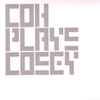 The title of this album couldnt possibly be more descriptive: using only audio recordings of Cosey Fanni Tutti’s voice, COH (a.k.a. Ivan Pavlov) uses her as an instrument. Small fragments of voice become melodious elements, phonemes become drums, and the smallest syllables are shaped into synthesizers. The result is an electronic work that simultaneously manages to be beautifully organic and completely alien.
The title of this album couldnt possibly be more descriptive: using only audio recordings of Cosey Fanni Tutti’s voice, COH (a.k.a. Ivan Pavlov) uses her as an instrument. Small fragments of voice become melodious elements, phonemes become drums, and the smallest syllables are shaped into synthesizers. The result is an electronic work that simultaneously manages to be beautifully organic and completely alien.
Some of the tracks here clearly retain the color of the original source material: "Sin-King" and "Inside" both are built on a foundation of obvious voice elements that are filtered or time-stretched to become more musical. Both also stay extremely quiet, occasionally approaching the territory of pure silence that requires careful listening to discern the subtle changes and variations in the recordings.
Two of the tracks are indicative of their titles: "Lost" features plaintive singing elements that are extremely low in the mix; they grow slowly in volume while disorienting time-stretching and unaffected screams and shouts appear, giving a sense of dark and confusing isolation. "Fuck It" is a slap-dash chaotic piece of stuttering sound fragments with Cosey delivering the titular line. Unlike the other pieces, there’s a sense of anger and frustration in the messy sound collage and fragments of voice.
Perhaps the most interesting tracks are the ones in which the voice elements are transformed into instrumentation that, without prior knowledge, one might assume to be just another sample or instrument. The most miniscule vocal sounds on "Mad" are sequenced intoto much more ; they resemble an arpeggiated synthesize and, mixed with the untreated vocals from Cosey, sound like the traditional software-inspired electronica for which the label is known. Similarly, "Crazy" turns syllables into synth leads and percussive clicks that are married with other sounds and shaped into what could be string instruments and, occasionally, untreated bits of vocals.
The closing "Lying" features an interesting approach, too: untreated vocals are meshed with pieces of other words and shaped into what sounds like background singers while other voices become saxophones and steady 4/4 beats. Essentially, a single voice becomes an entire electronic pop track. If nothing else, this album shows that Cosey Fanni Tutti, at least in the metaphorical hands of Ivan Pavlov, is not just an excellent performer, but a captivating instrument in and of herself. The natural character of her voice and the careful structuring and layering of Pavlov's arrangements makes for a lush album composed only of the most basic of sources.
samples:
Read More
- Administrator
- Albums and Singles
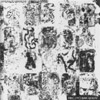 As one of the early pioneers in the industrial and noise fields, Bianchi never quite attained the same status as Whitehouse, Throbbing Gristle, or SPK. This might be because of his relatively short career: beginning as Sacher-Pelz in 1979 and continuing on under his own name until 1984, his time on the scene was brief, but prolific. This reissue of one of his classic albums is augmented both with bonus tracks and a second disc of obscure/bootlegged tracks that showcase one of the bleakest, most desolate musicians of his time.
As one of the early pioneers in the industrial and noise fields, Bianchi never quite attained the same status as Whitehouse, Throbbing Gristle, or SPK. This might be because of his relatively short career: beginning as Sacher-Pelz in 1979 and continuing on under his own name until 1984, his time on the scene was brief, but prolific. This reissue of one of his classic albums is augmented both with bonus tracks and a second disc of obscure/bootlegged tracks that showcase one of the bleakest, most desolate musicians of his time.
 
The two side-long tracks that make up the bulk of the original LP have an overall consistent sound of dank , low register synthetic pulses occasionally overrun by static-y, stuttering outbursts."Fetish Pinksha" moves along at a snail’s pace, the outbursts never taking hold over the otherwise slow, filmic sound."Sterile Regles" incorporates a shifting, lugubrious, low-tech drum machine pattern with pieces of tremolo heavy feedback resembling a proto-industrial funeral march. Synth elements that now characterize the dark ambient genre, along with squealing bits of feedback, give the sound an overall more frightening quality.
The two bonus tracks on this disc stem from compilation appearances around the same time span. "Placenta" has a more open, ambient science-fiction sound rather than the dark, gray ambience of the rest of the disc, while "Untitled" opens with the thumping, filtered, white noise that would soon become synonymous with the power electronics genre.It should be noted that the contents of this disc (including the mastering) are essentially identical to the release EEs’T put out some ten years ago.
The second disc, originally a Japanese bootleg titled Genocide of the Menses, collects previously rare bootleg tracks onto a single disc."Zyclombie" is another track of deep pulsing synths and sci-fi type oscillator sounds that originally appeared on the Japanese bootleg LP,  Leibstandarte SS MB 2. It sounds surprisingly good given its raw sources.The two-part title track originally appeared as a limited-to-18-copies acetate 7" and is more in line with the Mectpyo Bakterium album: dour minor synth chords and static heavy noise elements that never overpower, but serve as a nice counterpoint to the depressive sounds.The second part’s dive-bomb synths and overdriven low frequency elements are an obvious precursor to the likes of today’s Genocide Organ and Anenzephalia and other such folks.
The final four tracks originally surfaced on the bootleg M. B. Anthology 1981-1984 and show more of the variation of styles Bianchi employed throughout his career."Neuro Habitat" is twelve minutes of what sounds like a silent film score organ augmented with a slow, primitive drum machine pulse."Humus Nucleaire" features the same sort of rhythm track, but the synths have a lighter, more airy feeling to them, even though it doesn’t last. The raw electronics and beat boxes sound like a more lo-fi, slightly darker take on early Cabaret Voltaire.
While many of his peers relished the anger and violence that could be created using the early electronic instruments, Bianchi was content to paint a bleak canvas of gray sounds that are more depressing than malicious.Nevermoping or self-loathing, it is instead a dark, cold style that, after some 26 years, has obviously influenced a multitude of modern artists working at the extremes of sonic art.
samples:
 
Read More
- Administrator
- Albums and Singles
| (€12) |
- Rocket Sandals
- This Job Is So Boring
- Yellow Bedspring
- Better Universe No. 2
- Seedling Awakes
- Swing Low
This record contains 6 tracks:
Track one, Rocket Sandals is a pizzicato furioso (as opposed to fury piza) with a silent movie pianola, noisy banga banga and klavier delayage.
Track two, this job is So Boring was inspired by years, centuries, millenia, eternities of factory work, 8.30 - 5.30. producing expensive rubbish for people to buy on credit, so than they have to work in similar jobs. Experiment which proven I do not fit this kind of madness. factory went bust due to recession, the owners even had to sell their private helicopter! Not their numerous houses and cars though.
Track three: Yelow Bedspring - a pleasant little tune to make love to gently in a waltz time. It dissolves in a swimming shimmering wetness.
Track four Better Universe No. 2 is a collection of nice noises one encounters in dreams both sleeping and waking. It depicts green and lovely countryside, birds and bees, crunchy picnics with a nice bottle of beer, band playing with feeling and fabulous bike tearing about...
Track five Seedling Awakes - out of powerful darkness of earth slowly and unstoppably live surges up. Zither recorded in a large oak box specially constructed for this.
Track six Swing Low lighthearted but slightly sad re-visiting of and old gospel song, just reminding us what that promised land beyond Jordan is like. And yes there are many Jordans, and just as many shitty places beyond them.
Message is: do not bother dreaming about promised land, work thee not in a silly factory making somebody else rich, have a nice picnic, include a vintage bike if you like.
Read More
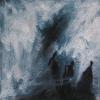 In recent years, Greg Anderson and Stephen O'Malley have pushed the live sound of Sunn O))) away from the typical riffs, robes, and dry ice formula. This release documents one of two site-specific performances given in Europe since 2006; here their hyper-amplified doom is played out within the confines of Bergen's Domkirken cathedral and utilizes the church's organ as well as its massive acoustics (the other performance being the Moog Ceremony concert in Brussels). Joined by some Sunn O))) regulars (as well as Lasse Marhaug), this is one of the better live albums by a group whose discography is peppered with savage live recordings.
In recent years, Greg Anderson and Stephen O'Malley have pushed the live sound of Sunn O))) away from the typical riffs, robes, and dry ice formula. This release documents one of two site-specific performances given in Europe since 2006; here their hyper-amplified doom is played out within the confines of Bergen's Domkirken cathedral and utilizes the church's organ as well as its massive acoustics (the other performance being the Moog Ceremony concert in Brussels). Joined by some Sunn O))) regulars (as well as Lasse Marhaug), this is one of the better live albums by a group whose discography is peppered with savage live recordings.
- Administrator
- Albums and Singles
 In recent years, Greg Anderson and Stephen O'Malley have pushed the live sound of Sunn O))) away from the typical riffs, robes, and dry ice formula. This release documents one of two site-specific performances given in Europe since 2006; here their hyper-amplified doom is played out within the confines of Bergen's Domkirken cathedral and utilizes the church's organ as well as its massive acoustics (the other performance being the Moog Ceremony concert in Brussels). Joined by some Sunn O))) regulars (as well as Lasse Marhaug), this is one of the better live albums by a group whose discography is peppered with savage live recordings.
In recent years, Greg Anderson and Stephen O'Malley have pushed the live sound of Sunn O))) away from the typical riffs, robes, and dry ice formula. This release documents one of two site-specific performances given in Europe since 2006; here their hyper-amplified doom is played out within the confines of Bergen's Domkirken cathedral and utilizes the church's organ as well as its massive acoustics (the other performance being the Moog Ceremony concert in Brussels). Joined by some Sunn O))) regulars (as well as Lasse Marhaug), this is one of the better live albums by a group whose discography is peppered with savage live recordings.
It is odd to think of a metal band being allowed to play in a church in Norway, let alone in Bergen itself, considering the havoc that those in the black metal community have caused in the past. It is especially surprising considering Attila Csihar is so connected with that scene, recording the sublime Die Mysteriis Dom Sathanas with Mayhem at the peak of black metal’s notoriety. Sunn O))) are always impressive live, but looking at the fantastic photography on the inner sleeves, I would imagine sitting in a cathedral looking at these robed figures playing such all-consuming music must have been mind blowing.
The first side of this double LP is one of the finest moments from Sunn O))) as it completely defies any expectations one could have of the group. Steve Moore begins the concert on the cathedral’s organ, creating an initially delicate drone and later builds the music up, embellishing it as he goes. All the while, Csihar’s vocals resonate through the bowels of the cathedral. Appropriately he takes influence from Gregorian chant before moving on to an almost operatic style. While he is never going to be found performing in a traditional concert hall with an orchestra, his vocals have long been one of the best things about Sunn O))) live. Here he struggles to stay in the same key as Moore’s organ but it works, his pained chants sounding suitably grim.
The other three sides of Dømkirke see the full line up for the evening’s ritual join the duo of Moore and Csihar (with Moore switching between being organist and his usual role of trombone player). A more usual Sunn O))) set ensues although at what seems like a lower volume than usual (so as not to literally bring the house down I presume). Marhaug and TOS Nieuwenhuizen’s electronics flesh out the already beefy sound of Anderson and O’Malley’s bass and guitar assault, the most apt description of the results being that it is a miasma of crashing chords and low end feedback. The only problem with the album is one that plagues all long recordings put onto vinyl: flipping it over mid-song. Luckily, the original performance was in twenty-odd minute chunks between changes in sound, but only side one finishes naturally. The breaks in the main bulk of the set do disrupt the flow of the performance but this is a minor quibble at worst.
Hardcore Sunn O))) fans have probably already heard this performance via the two bootlegs (audio and DVD) that were made available shortly after the performance occurred. Curiously, even though this double LP sounds pretty good, it does not quite capture the resonance of the building like the audience recording available in the CD-R trading world. That being said, I cannot see myself playing the bootleg much after hearing this.
Sorry, no samples as this is a vinyl-only release.
Read More
- Administrator
- Albums and Singles
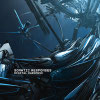 With their new album, Digital Darkness, Somatic Responses lay down the raw anger and metallic, broken, saw-edged decay of seized-up industrial breakdown. Their use of jagged, spastic beats, quickfire stabs of rusty chainsaw buzz, and acid-oil-tinged spikiness recalls the social price that was paid when the coal-mining industry in the South Wales valleys was devastated in the last century.
With their new album, Digital Darkness, Somatic Responses lay down the raw anger and metallic, broken, saw-edged decay of seized-up industrial breakdown. Their use of jagged, spastic beats, quickfire stabs of rusty chainsaw buzz, and acid-oil-tinged spikiness recalls the social price that was paid when the coal-mining industry in the South Wales valleys was devastated in the last century.
The environs of South Wales were in fact my original stomping ground, and although the mining areas weren’t part of my childhood territory, several members of my family had at one time been miners. The least likely place you would think to find hard, driving industrial electronic music is a small Welsh mining town. However, that’s exactly where the brothers Healey (John S. and Paul A.), the aural engineers behind Somatic Responses, hail from; a place called Ammanford to be precise. It doesn’t take much to imagine the effects on families when the mines were closed a decade or two ago. Listening to this album brings to the surface the memories of the social devastation caused to communities all those years ago. The vituperative venom spat out by newly-redundant miners on television newscasts is here reflected in the machine-gun delivery, the dirty, rasping, and grating slabs of sonic grit, and the almost feral ambience that envelops each of the fifteen tracks.
This is angry music. The only way to express that deep resentment and anger is through pure electronics, wrapped around a hefty drum’n’bass substructure. The sentiment is best encapsulated in track three, “Human Bass,” where a malice-tinged sample declaims, “The human race deserves to be wiped out.” Backing up this misanthropic pronouncement is a pumping bassline, upon which are hung rasps, squeaks, and crunches which aim directly for the pit of the stomach. The bitter acidity veritably drips off this song, collecting into sizzling and steaming pools of biting erosion.
Throughout the album it feels as though the miners were angry, but but not just the miners: the mines and machines themselves were, too. The music is liberally peppered with thunderously violent and mechanised outbursts; it features pounding, seismic rhythmic behemoths invested with a physical presence and weight, metallic clankings, twisted beepings, and scattershot skitterings like hordes of angry insects on the march, as well as self-propelled weaponry carrying the means for destruction on a massive scale. This is a gargantuan steamroller of an album; when cranked up to maximum it is fully intent on inflicting as much collateral damage as possible.
If I may have one minor criticism, it is that I that fifteen tracks are perhaps too much. In all honesty I think the numbers could have been reduced to about ten and it would still have been a strong, sharp album. By the end my focus was waning and everything was becoming blurry. I think that may simply be a result of the fact that this was made for a club environment and not necessarily in a home situation. The sound seems too contained here on a small stereo and cries out for a decent (read large and loud) sound system to best show it off.
Despite my reservation, this is, on the whole, a quality set of songs, displaying both strength and versatility. It features a finely-honed sense of song structure and a keen compositional ability. On Digital Darkness the Healey brothers stoke up the vast engines, set the controls to max, and let the monolithic structure go about its acts of wilful and unbridled destruction without hindrance. You can either get on board for the ride or you can get obliterated by the machine after it rolls over you. It’s as simple as that.
samples
Read More
- Administrator
- Albums and Singles
Brainwashed opened its doors on April 16, 1996, to host the websites for Meat Beat Manifesto and Greater Than One . It was built using discographies of Christopher Miller and wrapped in content and news and images from the artist as well as links to record companies and other resources fans might be interested in. The point of these websites was to provide a true central place for information on the web for a few musical artists, whereas a record label's website disregarded activity outside the record label and fan websites on places like Geocities had little in terms of information about the artists and their history.
Soon, Brainwashed had accumulated websites for bands Cabaret Voltaire , Coil , Current 93 , Death In June , The Legendary Pink Dots , Nurse With Wound , Organum , and Throbbing Gristle , because these websites existed but were hosted at colleges and universities, where the webmasters of these websites were graduating and moving on, either losing their space or simply not updating the websites any longer. The premise remained: provide as much information as possible for these artists including compltete discographies, image archives, and the latest news available.
In 1997, Brainwashed expanded to begin hosting websites for newer artists like Bowery Electric , Labradford , Tortoise , and Trans Am , and record labels including Kranky , Thrill Jockey, and World Serpent.
In 1998 we launched Brainwashed Recordings , basically to make recordings in small numbers as presents for the hardcore fans. All profits were to go back into the operating costs of Brainwashed but, as any industry professional will agree, there's really very little profits (if any) to be made on limited 7" singles and CD compilations!
In 1998, The Brain was begun: it was a weekly electronic magazine to post news about the bands and labels hosted at Brainwashed, along with provide some interesting feedback accumulated over the week, reviews of CDs, movies, books, and videos, a "link of the week," and what we're listening to. Soon, we were including sound samples with all reviews, something that no other noncommercial weekly Internet music publication was doing.
Over the next few years we accumulated more artists and labels and built The Brain into a virtually peerless publication, with contributing writers from all over the world, not just the existing Brainwashed staff and webmasters of the sites hosted.
In 1999, we laucnhed Brainwashed Radio , a 24 hour/7 day per week streaming radio station featuring music from all of the artists and labels hosted at brainwashed.
In 2000, with the increased evils surfacing in the media, we decided we would cease all support of major labels: they engaged in illegal (price-fixing and payola) and greedy (in-house publishing contracts and shifty bookkeeping) activities and we felt that we provided no true alternative if we were to review the same materials that all the major publications did. In the following years, they have further alienated their audiences and waged war against their consumers and artists and employees and promotional outlets and retailers that we continue the ban. It's no surprise their sales numbers have fallen over the years.
Also in 2000, Killer Pimp was launched as a separate identity from Brainwashed Recordings. This is a small label which hopes that with aggressive campaigns we can introduce some new music to the community.
In 2003, we launched The Eye , a weekly video feature with interviews and live footage of some of today's most exciting artists. Some of the features have been collected onto DVDs for fundraising purposes.
In December of 2004, we launched the Podcast Edition of Brainwashed Radio, where every week, Jon Whitney hosts an hour-long show featuring music from the artists and labels hosted at Brainwashed.
In August of 2005, we retired The Brain to reinvent Brainwashed.com, where content is provided daily, as news can't wait for once per week. The new system is searchable with archives of all old reviews and content from the old way of doing things.
In 2006, we celebrated our 10th year of online existence with the first Brainwaves Festival : a three day music fest featuring friends and family of Brainwashed.
In 2008 we are throwing another Brainwaves Festival. Brainwaves 2008 lineup now stands as: Threshold HouseBoys Choir , JG Thirlwell's Manorexia , Meat Beat Manifesto , Matmos , Stars of the Lid , Little Annie , Silver Apples , Windy Weber (of Windy & Carl ) & Thomas Meluch (of Benoit Pioulard ), Major Stars , Reformed Faction ( Mark and Robin of Zoviet France, Rapoon , Dead Voices On Air), Andrew Liles and Jonathan Coleclough , Nmperign feat. Jason Lescalleet , Marissa Nadler , Glenn Jones , His Name Is Alive , Gary Wilson , Rivulets , Strategy , Nudge , Boduf Songs , To Kill A Petty Bourgeoisie , Lichens + DJ Steven Stapleton & a special Greater Than One video presentation.
Sign up for our mailing list here to get the latest updates on Brainwashed Recordings releases before anybody else and the updated news on the Brainwashed 10th festival (tentatively being titled BWX).
Thank you for your interest and support.
Jon Whitney
Prinicipal, Brainwashed
Read More
- Administrator
- Albums and Singles
 There are the usual features that Masami Akita employs in his work: mastering at a face-melting volume, piercing high pitched noises, sand-blasting roars of sound, and, particularly in recent years, the obligatory Save the *insert animal here* artwork. On this last point Akita is normally very heavy handed and just slaps a picture of the animal on the cover or some less than subtle point about vivisection (but then is there anything subtle about a man who has spent his life trying to deafen the world) but on Dolphin Sonar he has made a far more concerted effort at a protest album. All of the sound here can be described as manmade violence or Akita's representation of marine life as envisaged by the dolphin; his anger is directed at where the two ideas meet.
There are the usual features that Masami Akita employs in his work: mastering at a face-melting volume, piercing high pitched noises, sand-blasting roars of sound, and, particularly in recent years, the obligatory Save the *insert animal here* artwork. On this last point Akita is normally very heavy handed and just slaps a picture of the animal on the cover or some less than subtle point about vivisection (but then is there anything subtle about a man who has spent his life trying to deafen the world) but on Dolphin Sonar he has made a far more concerted effort at a protest album. All of the sound here can be described as manmade violence or Akita's representation of marine life as envisaged by the dolphin; his anger is directed at where the two ideas meet.
Across the three pieces, swirls of bloodied noise are pierced by Merzbowed sonar sounds (especially in "Part 2"). In the bubbling electronic squall, it is almost possible to see the pink foam on the red sea from the slaughter of the dolphins. As there is not really anything more that can be done with extreme noise in terms of aesthetics (no matter who is behind the laptop), the only thing that can be done is pair the noise with a meaning. Akita has never truly managed to link his ideological stance with his music prior to this and this consummation of that marriage between thought and sound is staggering. Considering Akita’s work is usually so abstract, to find such concrete imagery in his composition is as shocking as that first time you heard his work.
[On a nitpicky note, I feel I must correct the “facts” about dolphin brains in the liner notes. Yes indeed dolphin brains are larger than ours (as are many creatures) but the jury is well and truly out as to whether they are more complex than ours. As for the notion that we have three-lobed brains and they have four, that is a complete fallacy. Both dolphins and humans have four lobes in each hemisphere (namely the frontal, parietal, occipital and temporal lobes). Yes the wholesale killing of dolphins is not something humans should be pursuing but please, get your neuroanatomy right!]
This is a fine example of why Merzbow is still relevant and how powerful he can be. It is also a rare instance of sound art being put to good use, I may not agree with him on all points but he has certainly got me on his side here.
samples:
Read More
- Administrator
- Albums and Singles
 There has been no shortage of metal-tinged instrumental bands these last few years but few can pull it off like Boston's heaviest band. The Touch Records style cover can be quite deceptive: what lurks inside is equal part rock monster and rock ogre; it starts with a bang and finishes with a louder bang.
There has been no shortage of metal-tinged instrumental bands these last few years but few can pull it off like Boston's heaviest band. The Touch Records style cover can be quite deceptive: what lurks inside is equal part rock monster and rock ogre; it starts with a bang and finishes with a louder bang.
Hesperus is their first proper release for a while (their last EP being a remix CD) and it is a stomper. The music is not the bludgeoning Boris/Pelican/Isis brand of metal that they are usually classified under, in fact it is barely even metal. What this album sounds like is a hypothetical situation where the boys from Dirty Three have found themselves in a recording studio without their equipment but manage to get a loan of Tool’s gear. The jamming is that frenetic, passionate channelling of energy that Dirty Three are known for but the aesthetic is definitely modern heavy rock. I admit this description is strange (and probably a little off-putting) but believe me, it works. What makes it all the more remarkable is that, despite sounding like a four piece, 5ive are a duo (which makes me wonder how they happened upon the name?).
Short pieces like “Kettle Cove” and “Big Sea” combine the crushing weight of largely amplified guitars with a very fluid and loose style of playing; it never feels like the group are trying to introduce elements and time changes to make the music more complicated (as often is the case with instrumental music). The final two tracks, “News I” and “News II,” take up nearly half the album and Hesperus is all the better for it. There are times where the music strays into generic post-rock territory but 5ive always manage to pull it back into more engaging directions.
While there may be no reinvention of the wheel here, there is more than enough enthusiastic playing here to make Hesperus a worthwhile. The fact that there are no gaps that need filling (vocalist? Pfffft!) combined with the breadth of music on offer is striking, all the more considering the fact that it is such a small band making such a huge sound. Those familiar with 5ive will know what they are getting into (and it is even better than normal, trust me) and those who think they are a boyband from the UK, this blows those wusses away.
samples:
Read More


